Voting
Politics determine how power and resources are distributed.
The Census is used to apportion voting in state and federal elections. It continues to count people who are incarcerated in the location that they are incarcerated instead of where they lived prior to incarceration.
(Source: Prison Policy Initiative)
Comparing the 2011 redistricting maps with 2001 maps shows evidence of cracking (spreading voters out to dilute voting power) in Milwaukee County. 2018 election results reflect the continued impact from 2011 gerrymandered redistricting.
(Source: UW Applied Population Labs WisContext, Milwaukee Journal Sentinel)
The Wisconsin Court of Appeals District 4 has issued a stay after an Ozaukee Count Judge ordered more than 200,000 voters off Wisconsin voting registration rolls. The voters were to be purged due to not responding within 30 days to a letter sent by the Wisconsin Elections Commission. Milwaukee and Madison voters are over represented in this purge as they represent 14% of the total registered Wisconsin voters, but received 23% of the letters.
(Source: Wisconsin Elections Commission Letter, Milwaukee Journal Sentinel, 2019)
Voter Suppression
In the United States, we elect government representatives to make decisions on our behalf. These governmental leaders determine how power and resources are distributed in society. They make laws that impact our daily lives.
Eligible voters can cast their vote in elections for their preferred candidate to represent them in local, state, and national offices. Many eligible voters don’t vote. Reasons for not voting include not liking the candidates or the campaign issues, too busy or scheduling conflict.[i]
Voter suppression tactics also impact voter turnout. The 2013 Supreme Court’s 5-4 decision on Shelby County v. Holder took away a key provision in the Voting Rights Act of 1965. After this decision, “at least 23 states have enacted newly restrictive statewide voter laws”.[ii]
Voter Suppression Tactics:
Voter Identification Laws
Qualifying identification is required to vote in Wisconsin.[iii]
- In 2011, ACT 23 Voter ID law passed in Wisconsin.
- No evidence of voter fraud.
- At that time 9% of all Wisconsin registered voters lacked approved ids.
- This law disproportionately impacted people of color. [iv]
- In 2011, ACT 23 Voter ID law passed in Wisconsin.

- Law disproportionately affects minorities, the elderly, students, people with disabilities, and low-income and homeless voters[v]
- One of the approved forms of ids is a Wisconsin Driver’s License. After the new voter id law was passed in 2011, Department of Motor Vehicles hours were reduced in Milwaukee and Madison, but hours were expanded in the suburbs and rural areas.[vi]
- Groups that filed lawsuits against ACT 23 include:[vii]
- Wisconsin League of Women Voters (10/20/2011)
- ACLU & the National Law Center on Homelessness & Poverty (12/13/2011)
- Milwaukee branch of the NAACP (12/16/2011)
- League of United Latin American Citizens (LULAC) of Wisconsin (2/23/2012)
- The ability to obtain accepted forms of identification for voting is connected to economic/poverty issues, housing, and age.
- Voter Registration and Early Voting Restrictions
- Federal Judge stuck down early voting restriction laws passed in December 2018 by Wisconsin Legislature in a lame duck session.[viii] The law would have limited voting to two weeks before an election.
- Cities like Milwaukee and Madison would have been impacted by this law. The City of Milwaukee offered early voting for six weeks prior to the November 2018 mid-term elections.
- Voter Purges
- The plaintiffs (3 suburban Milwaukee men backed by the conservative Wisconsin Institute for Law & Liberty) requested their lawsuit to have voters purged off of voter rolls be put on the fast track.
- Wisconsin Court of Appeals District 4 stays the voter purge.[ix]
- Voters who were subject to the purge who have not contacted the Wisconsin Election Commission will have a watermark by their names in the poll book. This should prompt the poll worker to ask if the voter has moved.
- Voters who have not moved can affirm this by signing the poll book.
- Voters who have moved will be directed to reregister to vote at their new address.
- Ozaukee Count Judge orders more than 200,000 voters off Wisconsin voting registration rolls due to not responding within 30 days to a letter sent by the Wisconsin Elections Commission.
- Milwaukee and Madison voters are over represented in this purge as they represent 14% of the total registered Wisconsin voters, but received 23% of the letters.
- Voters who were subject to the purge who have not contacted the Wisconsin Election Commission will have a watermark by their names in the poll book. This should prompt the poll worker to ask if the voter has moved.
- Federal Judge stuck down early voting restriction laws passed in December 2018 by Wisconsin Legislature in a lame duck session.[viii] The law would have limited voting to two weeks before an election.
To view Carol Anderson’s One Person, No Vote video, click here.
Felony Disenfranchisement
In Wisconsin, people with felony convictions can’t vote until they have completed their incarceration along with any probation, parole, or extended sentence. Voting rights are restored for pardoned individuals. Re-registering to vote is also required.[x] For further information for ex-felon and incarcerated voters, click here.
- Wisconsin felon disenfranchisement more restrictive than 20 other states.
- Estimated that more than 62,000 Wisconsinites are disenfranchised.

- Wisconsin has the 11th highest rate of African- American voter disenfranchisement.[xi]
- 1 out of 50 Wisconsin voters are disenfranchised
- In Wisconsin, 1 out of 9 African- Americans disenfranchised

- Voting disenfranchisement is connected to mass-incarceration.
- In Milwaukee County, over 50% of African American males have served time in prison.[xii]
- Wisconsin incarceration disparity of non-whites and whites is above the national average.
- S. African American 5 times more likely to be incarcerated than whites, but in Wisconsin the African Americans are 10 times more likely to be incarcerated than whites.
- Wisconsin also has one of the highest disparities for the incarceration rates of Native Americans and whites.[xiii]

Gerrymandering
- Every ten years, the U.S. Census is used to reapportion voting districts for Congressional and state legislatures. Gerrymandering happens when the redistricting (the dividing political districts at the local, county, and state level) is done to advantage one political party over another. Gerrymandering can be done by Packing, Cracking, or Stacking. Both political parties have done gerrymandering.
- Cracking is spreading like-minded voters out into different districts. This is done to dilute their voting power.
- Packing is concentrating like-minded voters into a single district. This reduces their influence in other districts.[xiv]
- Stacking involves creating districts with equal numbers of low income less educated voters (typically more likely to vote Democratic) with high income more educated voters (typically more likely to vote Republican). Higher income voters have higher voter turnout rate. The result of stacking is districts that are more likely to favor the Republican Party. [xv]
- Every ten years, the U.S. Census is used to reapportion voting districts for Congressional and state legislatures. Gerrymandering happens when the redistricting (the dividing political districts at the local, county, and state level) is done to advantage one political party over another. Gerrymandering can be done by Packing, Cracking, or Stacking. Both political parties have done gerrymandering.
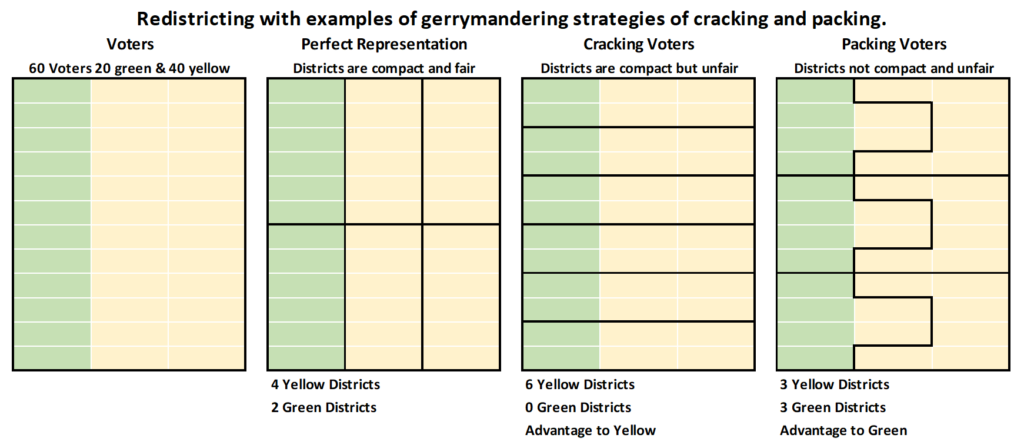
- In Wisconsin, the State Legislature controls the redistricting process.
- Redistricting was done after the 2010 Census by a Republican controlled legislature that had a majority in both the Senate and Assembly and held the Governor’s office as well.
- A group of 12 Democratic Wisconsin voters challenged the 2011 redistricting plan in court. The group stated gerrymandering, both cracking and packing, unfairly disadvantaged Democratic candidates. Efficiency gap metrics[xvi] were used to show the overall impact of gerrymandering on voters.[xvii],[xviii]
- The lawsuit, Gill et al. v. Whitford et al., went all the way to the United States Supreme Court. The June 2018 Supreme Court ruling did not offer a judicial remedy to gerrymandering. Instead the court ruled the plaintiffs lacked standing, which meant the plaintiffs did not show specific personal harm to someone involved in the lawsuit. The lawsuit was sent back to the trial level.[xix],[xx]
- The Wisconsin Constitution requires districts to be drawn with equal numbers of people, follow county, precinct, town or ward lines, be contiguous and compact as practical.[xxi]
- The 2011 redistricting maps as compared with the 2001 maps show evidence of cracking at the Milwaukee County level.
- The 2001 maps mainly followed the Milwaukee County boundaries in the suburbs. But the 2011 map, democratic voters were cracked and spread in the central and near suburban areas into districts in neighboring counties that were more wealthy, white, and conservative.[xxii] To see the maps, click here.
- For a detailed explanation of the facts and analysis of Gill et al. v. Whitford et. al, click here.[xxiii]
- To compare the 2001 vs 2011 Wisconsin Assembly district maps using results from the 2016 election, click here.[xxiv]
- 2018 election results reflect the continued impact from 2011 gerrymandered redistricting.
- According to Milwaukee Journal Sentinel analysis, “64 of the 99 districts are more Republican than the state as a whole based on their vote for governor.”
- The Republican built in advantage will help them maintain control of the WI State Assembly even in “bad” years for the Republican Party. In 2018, Democrats won 53% of all Assembly votes, but carried only 36% of the seats.[xxv]
- The 2011 redistricting maps as compared with the 2001 maps show evidence of cracking at the Milwaukee County level.

- According to a January 2019 Marquette Law School poll, 72% of Wisconsin voters want a nonpartisan commission to do redistricting.[xxvi]
- A Fair Maps Constitutional Amendment has also been introduced in the Wisconsin State Legislature to ban gerrymandering. Senate Bill 288 and Assembly Bill 303 are currently pending in the legislature.[xxvii]
- 50 out of 72 Wisconsin Counties have passed fair maps resolutions.[xxviii]
- On April 7th, 2020, Milwaukee County voters will have the opportunity to vote on a non-binding referendum for a non-partisan way of drawing redistricting maps. The Milwaukee County Board has already passed a resolution in favor of non-partisan redistricting.[xxix]
- According to a January 2019 Marquette Law School poll, 72% of Wisconsin voters want a nonpartisan commission to do redistricting.[xxvi]
For historical to present day perspective from Reggie Jackson on blacks exercising their voting rights, click here.[xxx]
There is a connection amongst the voting rights issue and other issues like mass incarceration, housing, education, and economics.
2020 Census
Be counted in the 2020 Census. There is NO citizenship question on the 2020 Census.[xxxi]
A census, which counts of all people residing in the United States both citizens and non-citizens, is required by the Constitution every ten years.
Census information is used for:
- Reapportioning the voting districts for Congress and state legislatures.
- A state’s Electoral College votes is the total number of representatives (determined by the census) plus the two senators for the state. The Electoral College vote is used for determining the winner in Presidential elections.
- Allocating funding for social services at the federal level including:
- Medicaid
- Supplemental Nutrition Assistance Program (SNAP)
- Medicare Part B
- Highway Planning and Construction
- Federal Pell Grant Program
- Allocating for federal matching funds for state programs like:
The Supreme Court, in a 5-4 ruling, found that the reasoning for adding the citizenship question to the 2020 Census was “arbitrary” and violated the Census Act.[xxxiv] Immigrants’ rights groups, 18 states, 15 cities and counties, the District of Columbia, and the U.S. Conference of Mayors and the ACLU brought the lawsuit against the Trump Administration.[xxxv] The purpose of the census is to get an accurate count. The Supreme Court found that including the citizenship question would likely result in lower rates of response from noncitizens.[xxxvi] Census Bureau Experts predict that adding the citizenship question would skew the self-reporting results and drive up census costs.[xxxvii]
Proposed Census Question Strategy to Advantage Non-Hispanic Whites
Emails from a Republican strategist, Thomas Hofeller show email contact with a Census Bureau Official starting in 2015 regarding the citizenship question. Hofeller’s unpublished study asserted that adding the proposed citizenship question on the census could help give an advantage to Republicans and non-Hispanic whites as the census is used to redraw voting districts. [xxxviii]
2020 Census prison-based gerrymandering.
- Will continue to count incarcerated people as residents of where they are incarcerated, even though they can’t vote, and return to their homes after release
- Distortions occur when districts with large prison populations are over-represented and areas that have their residents sent out of the district for incarceration are under-represented. [xxxix]
- In the 2010 Census, the following Wisconsin locations did not participate in prison-based gerrymandering[xl]:
- Crawford County (Prairie du Chien is in Crawford County)
- New Lisbon, Portage, Prairie du Chien, Stanley
The Census Bureau is seeking to find a balance between personal privacy and data accuracy. Title 13 requires that no census data is published that would identify and individual or business.[xli] Reported results of 2020 Census will use a new “differential privacy” algorithm which adds “noise” to distort the data to protect privacy. The amount of “noise” has not been determined. The Census Bureau is aware of the concerns about the impact of this new algorithm and is working to address them.[xlii]
- Reported state level data will be accurate and match the raw data.
- Reported data below the state level (regional, county, city, etc.) will not match the raw data. It will be intentionally distorted to protect personal privacy.
- Some concerns about the new algorithm include:
- Reported data will likely show distortions with rural areas having increases in population and urban areas having decreases in population compared to the raw data.
- This raises questions about whether the data will be accurate enough to properly do redistricting within a state and at the local level and also the impact on the distribution of federal funds.
- Groups that have smaller populations, such as specific racial groups will be impacted more than racial or ethnic groups with larger populations.
- Census data is used in many longitudinal studies (economic, health, education, etc.) greater distortions to the raw data to protect privacy may compromise current studies and make new studies more difficult.
- Reported data will likely show distortions with rural areas having increases in population and urban areas having decreases in population compared to the raw data.
- Some concerns about the new algorithm include:

How well are you represented?
The United States is a representative democracy. Elected representatives; however, don’t always reflect the people and communities they represent. White men hold 62% of the elected positions across the United States, while only composing 30% of the population. This is a sharp contrast to people of color. Women of color comprise 20% of the U.S. population, while only 4% of U.S. elected officials. Men of color are 19% of the U.S. population and 7% of U.S elected officials.[xliii]
In 2018 in the U.S., most political candidates were white: 80% of Democratic candidates were white and 96% of Republican candidates were white. But research on the 2018 election results showed, “when they’re on the ballot, women of all races and men of color win elections at the same rates as white men.” Women of color made gains in the 2018 U.S. elections at the county, state, and congressional level. [xliv]
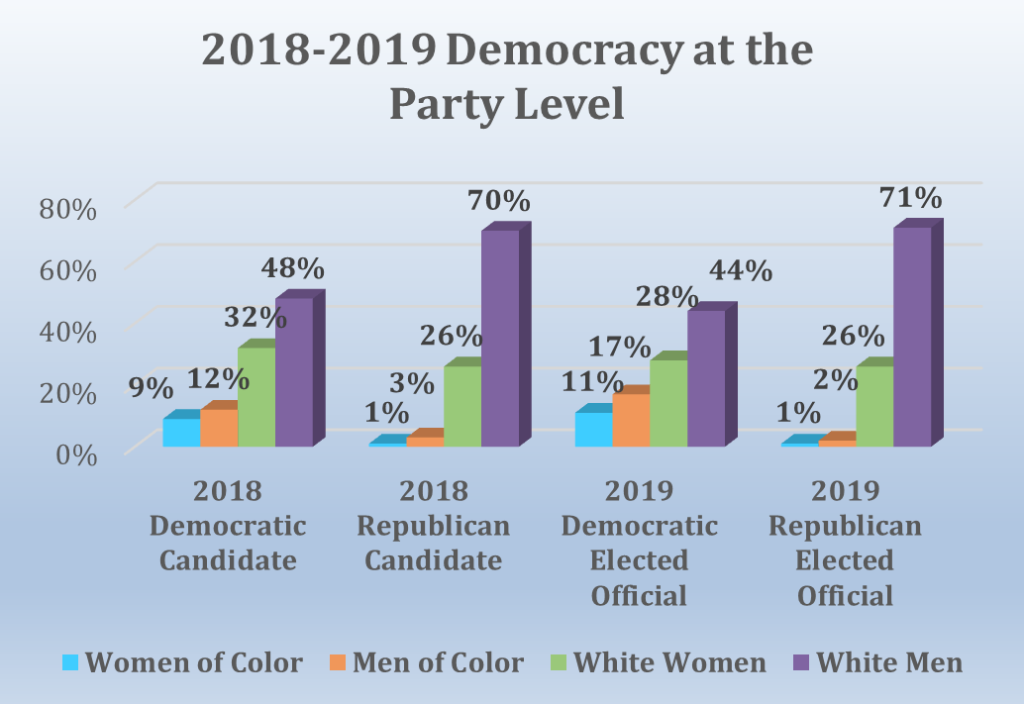
Public prosecutors may have the most power in the criminal justices system. For further information on the power of prosecutors, click here. Prosecutors decide whether to dismiss a case or prosecute someone, what gets charged, whether to offer a plea deal, and offer recommendations on bail or jail before the trial.[xlv] A study conducted by Carlos Berdejò of the Loyola Law School used data from the Wisconsin Circuit Courts. He found “white defendants were 25% more likely than black defendants to have their principal initial charge dropped or reduced to a lesser crime.” This resulted in white defendants less likely to have a felony on their record than blacks. White defendants were also more likely to have misdemeanor charges with no jail time or to have them dropped than blacks. Low-level felonies and misdemeanors also show greater racial disparities in plea bargaining.[xlvi]
In the U.S., 95% of elected prosecutors are white. From 2015 to 2019, more white women have been elected to this position while white male election rates have seen a decrease. 80% of elections for prosecutor are unopposed. In 2018, “when women of all races and men of color ran for contested prosecutor elections, they were more likely to win than white men.”[xlvii]
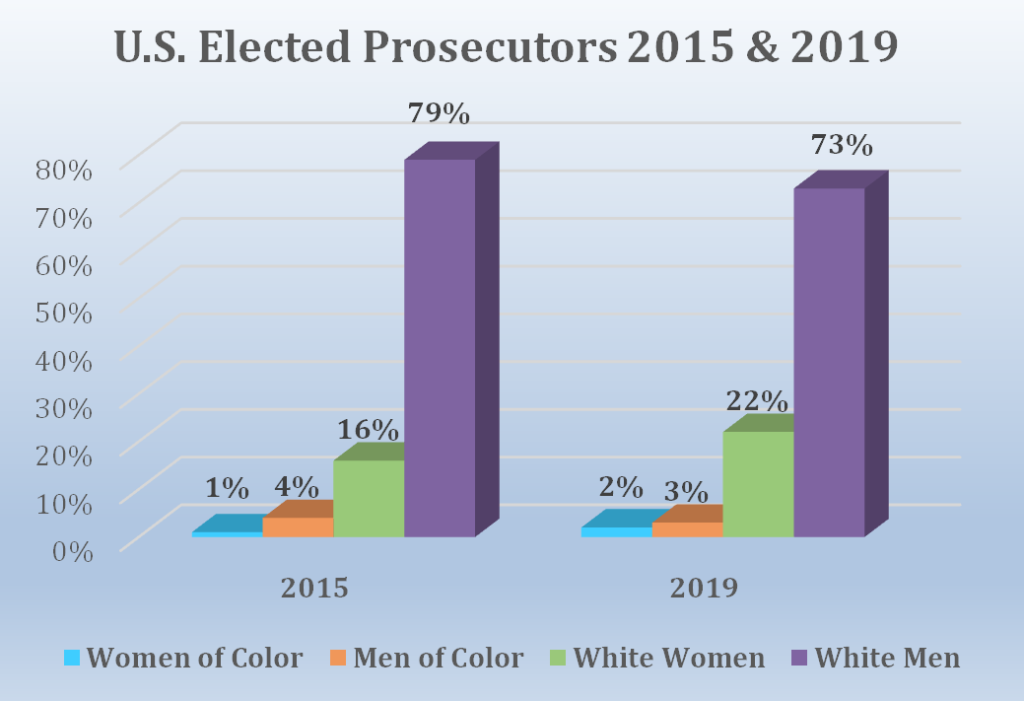
In 2017, more than 95% of all court cases in the U.S. are filed in state courts.[xlviii] In Wisconsin, judges are elected. 76% of these judges are white men. Women and people of color are under represented on the judicial bench when compared with their proportion of the Wisconsin population.[xlix],[l]
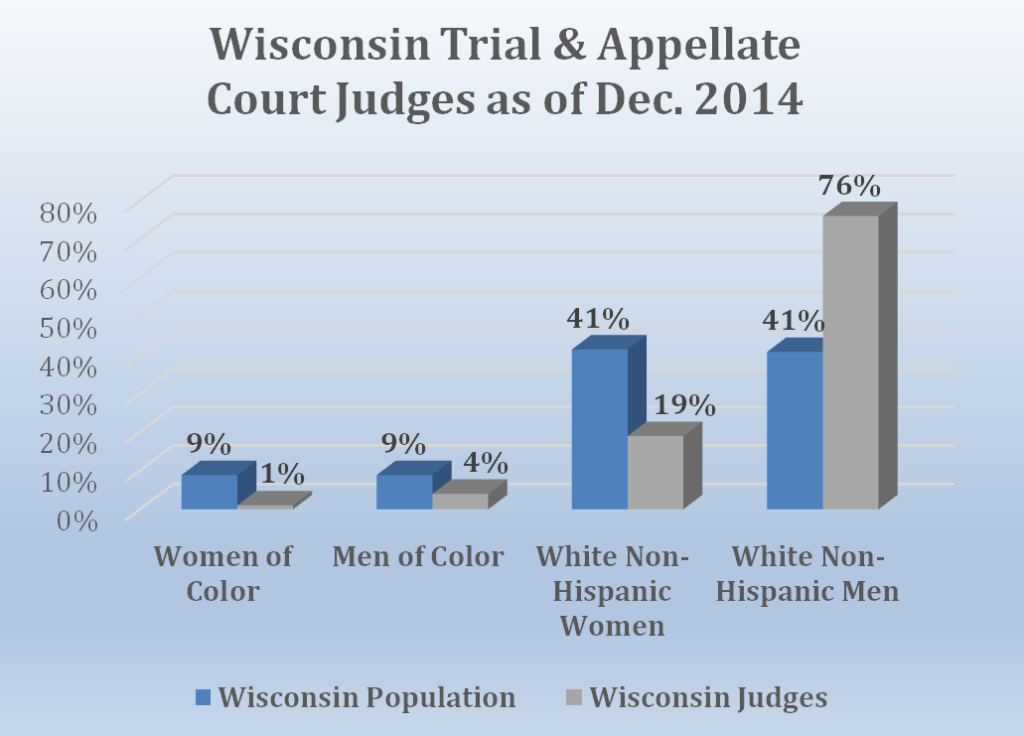
Running for an elected office:
For the requirements to run for office in the City of Milwaukee, click here.
Barriers to running for an elected office include:
Money – Running for office is expensive. Political parties, individual donors, candidates themselves, and individual interest groups all try to influence the outcome of elections through monetary contributions.[li] Typically, money goes to those with more power, which usually means incumbents.[lii]
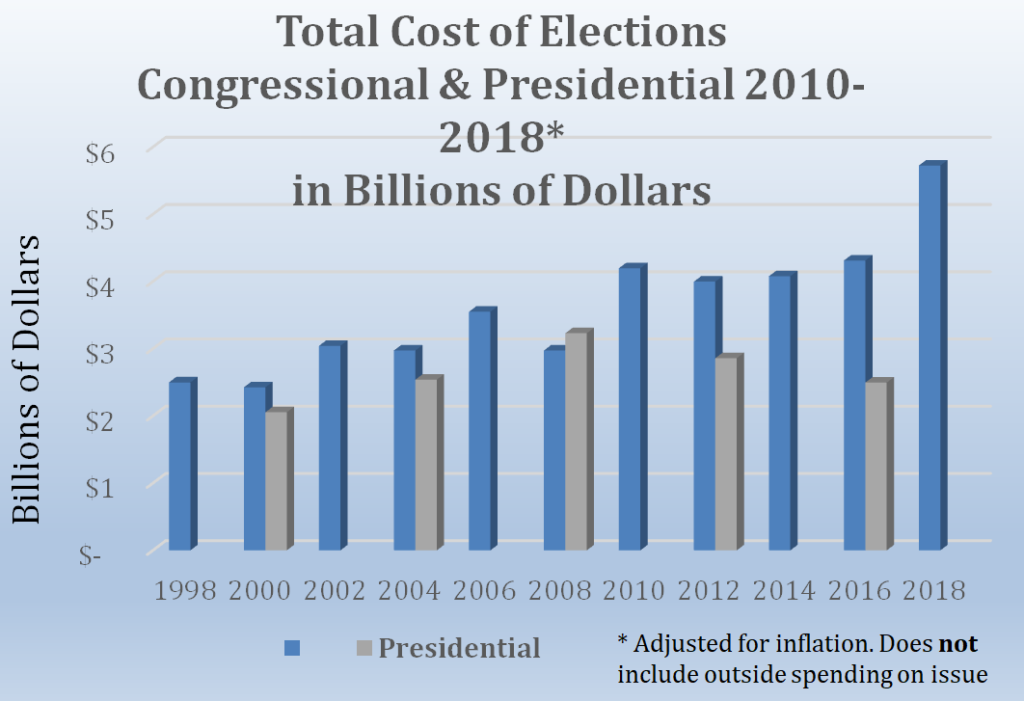
In January 2010, the Supreme Court ruled in a 5-4 decision on Citizens United. The Supreme Court ruled that political spending to support or oppose candidates for federal office by corporations, unions, and associations is a form of free speech that is protected by the First Amendment. The ruling allowed for corporations, unions, and associations can have unlimited independent spending on political issue ads. [liii], [liv] The dissenting four justices voiced concerns about corruption and the unlimited spending (free speech) of some on political ads by some could dilute the free speech of others.[lv]
To learn more about the Citizens United ruling, click here.
Do you know who’s trying to influence your vote?
Political Action Committees (PACs) are organized to raise money to help elect or defeat candidates for political office. PACs have existed since 1944. PACs can make direct contributions to political parties or candidates and need to register with the Federal Elections Commission and follow federal spending limits.[lvi]
After the Citizen United ruling, outside spending increased with the formation of Super PACs and more dark money in politics.[lvii]
- Super PACs raise unlimited money and only make independent political expenditures. Super PACS must not coordinate this spending with candidates or parties. They also need to disclose their donors.
- Non-profits that are registered as 501(c) (4, 5, & 6) organizations such as social welfare, labor & agriculture, or business & trade groups are allowed to spend part of their money on political issue ads.[lviii] Spending by non-profits on candidate attack ads instead of policy ads has increased in recent years. These non-profits do not need to disclose their donors. This has resulted in lots of dark money in politics where the source of the money is unknown so voters don’t know who is trying to influence their voting behavior.[lix]
According to the Center for Responsive Politics, spending on federal elections has increased since the Citizens United ruling. The figures in the chart don’t capture all the spending as non-profits aren’t required to report their independent spending to the Federal Elections Commission.[lx]
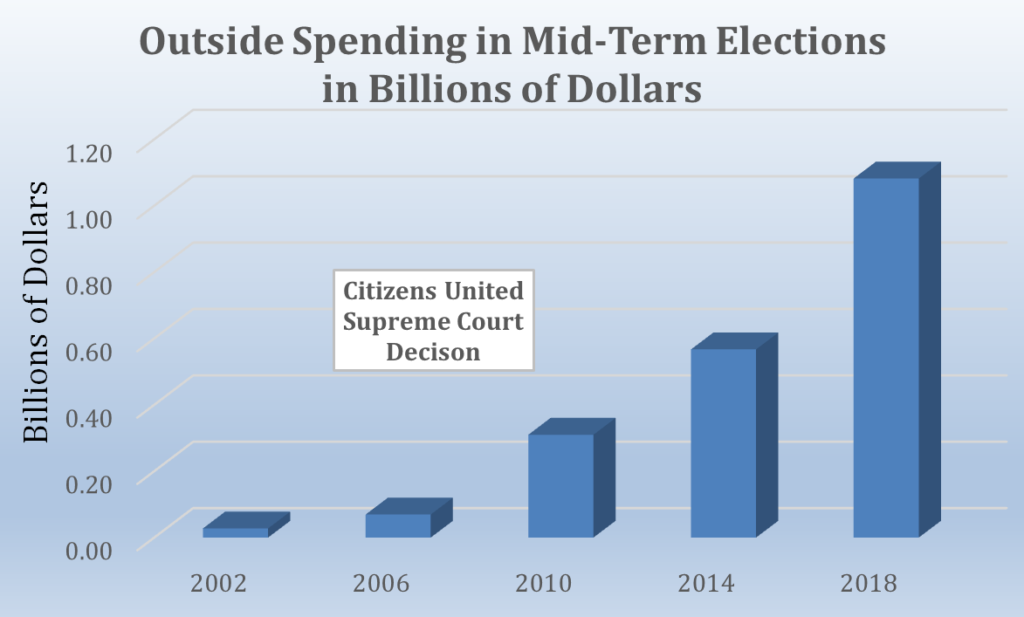
Political money in Wisconsin:
- Wisconsin and Florida are the only states that allow coordination for “issue advocacy” legal between candidates and outside special interest groups.
- Contributions to issue ads are not reported to the Wisconsin Elections Commission.[lxi]
- As of 2016, campaign donors of $200 or more in a calendar year only need to disclose their occupation. Prior to that donors of $100 or more per calendar year needed to disclose their employers and their occupation.[lxii]
To learn more about big money in politics, click here. For Wisconsin specific information, click here.
Resources for voting information:
For Rid Racism civic activism and voting information, click here.
In the 2018 House of Representative races, on average Black/African American women had the least amount of money in their campaign coffers followed by Black/African American men.[lxiii]

Gerrymandering – Gerrymandering can diminish the voices of an under represented populations and make it more difficult for those voices to elect officials that represent their interests.
- According to ProPublica, when gerrymandering happens by either party, Democrats or Republicans, minority voters are harmed.[lxiv]
- Republicans benefit by packing minority voters into a few districts. This leaves the remaining districts safer for Republican candidates.
- Democrats benefit by cracking minority voters across a number of districts to ensure a democratic majority in those districts. The minority voters may have had more political power had their voices not been diluted by cracking.
